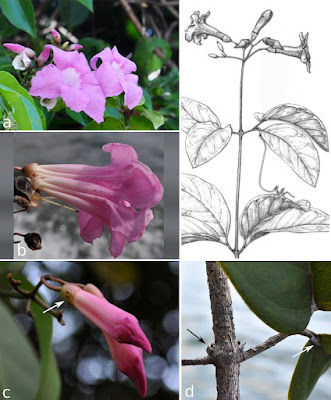 |
| Tanaecium decorticans Frazão & L.G.Lohmann, in Frazão & Lohmann, 2018. |
Abstract
Tanaecium (Bignonieae, Bignoniaceae) is a genus of Neotropical lianas that is centered in the Amazon. The genus exhibits interesting patterns of morphological variation, especially in terms of flower morphology. Despite that, the group remains poorly known, lacks a phylogeny and a taxonomic revision. While working on the systematics of Tanaecium, we encountered a morphological variant of Tanaecium pyramidatum from the Brazilian Amazon that represents an independent evolutionary lineage and differs from that species in various morphological traits. This taxon is here described as Tanaecium decorticans, sp. nov. While T. decorticans is sister and most morphologically similar to T. pyramidatum, it differs in the peeling epidermis (vs. not peeling in T. pyramidatum), presence of an arrow-shaped petiolule (vs. absence of an arrow-shaped petiolule in T. pyramidatum), and interpetiolar region covered with fields of glandular trichomes (vs. aglandular interpetiolar region in T. pyramidatum), among other characters. This finding highlights the importance of in-depth taxonomic studies of individual lineages for an improved understanding of the Amazonian biodiversity.
Keywords: Amazonia, Lianas, Neotropical biodiversity, Taxonomy
Tanaecium decorticans Frazão & L.G.Lohmann, sp. nov.
Etymology: The species epithet refers to the stem with peeling epidermis.
Annelise Frazão and Lúcia G. Lohmann. 2018. A New Species of Tanaecium (Bignonieae, Bignoniaceae) from the Brazilian Amazon and Its Phylogenetic Placement. Plant Systematics and Evolution. 304; 1245–1253. DOI: 10.1007/s00606-018-1544-x [05 October 2018]

